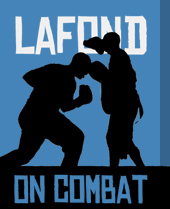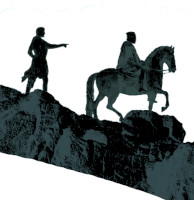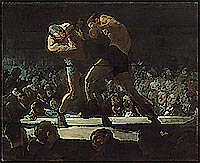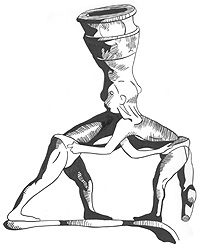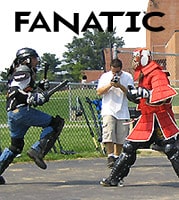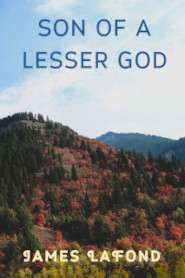Special Forces of the Ancient World?
Our current military history buffs—including novelists and movie makers—tend to be most interested in ‘special forces’. Hence, most of us non-military people figure that the Special Forces guys are the hammer, the combat arm that wins battles. According to John Keegan, one of our foremost military historians, warfare is not evolutionarily too far away from a point where all combat operations will essentially be conducted by special operations units and that conventional forces will be analogous to the ancient fortification around a city.
However, when you talk to Special Forces people they always have the creeping sense of being vulnerable and outgunned. These are smart men who now that they cannot sneak around, swim, sky-dive and climb with the firepower that grunt line units pack as a matter of course. What is most interesting about this situation to me; is that the ancient units that get all of the modern press are conventional line units. There is not much mention of special light units.
A good example is the Spartans. To read the history you would think they had no light troops. They did have their helot peltasts. But the peltasts were low status combatants who were written out of the history.
Now, if one reads between the lines, one begins to see the shadow of the light-armed special operations warrior of the ancient world in some obscure passages. Below are some examples, one being from a medieval source.
The ownership of the precinct of Olympia was once decided by a duel between a slinger and an archer. This was a hand-to-hand duel. This tells us that, as individual combatants, light troops were highly regarded. This makes sense since light troops fought in a looser formation.
During the Peloponnesian War a force of Spartans were cut off on an island in rough terrain by light troops and forced to surrender, completely humiliating their entire nation.
The entire ‘game’ of gladiatorial combat was built around ‘heavy’ versus ‘light’ warrior types. The implication is that once formations of heavy troops are broken up and dispersed, their heavy weaponry becomes a tradeoff, and a duel between a ‘heavy’ and a ‘light’ becomes quite a chess match.
During King Richard’s campaign in the Holy Land during the Crusades there was a grinding parallel march along the coast by the Christian and Islamic armies. Eventually the two sides settled down to watch a duel. The duel was not between a Christian knight and Muslim heavy horseman, but between two archers.
Going back to the ancient period one should take a look at the Iphicratic trooper. A famous Athenian captain named Iphicrates lightened the armor and reduced the shield size of his heavy fighters even as he lengthened their spears and swords. These fighting men became much sought after allies and feared opponents.
To further develop the point for the ancient light-fighter being a renowned operational specialist akin to his modern counterpart, let’s take a look at a particularly well-travelled and infamous type of peltast.
#7: Agrianian Javelin Men, 336-323 B.C.
The Macedonian military machine under Alexander the Great is the greatest elite combined-arms fighting force ever to march into battle. And, in 336 B.C., when your new boss Alex takes over as Warrior King of Alcoholic Macedonia, nothing like the army you belong to has ever been fielded. Alex and his old man took you guys for a test run a few years ago. But the best modern analogy for the Macedonian Army in 336 B.C. would be the German Army in 1939. The rest of the world was in for an ass-kicking.
The unstoppable anvil of the army is the mass of foot-slogging phalangites with their spears as long as three men are tall. These dummies aren’t worth a shit in broken terrain. Among your many tasks is to make sure they do not get mugged on the way to the field party.
The dreaded hammer of the army is the horse companions, the boy king’s own drinking companions on their snorting steeds. Do you think these rich murderers are going to draw any of the shitty details? In your homeland only chiefs and kings have horses.
Their counterparts are the Foot Companions, elite old style hoplites who work as the hinge of the army. These guys you respect. You often serve as their eyes, ears and claws, with them providing the jaws.
There are many jobs to be done in an ancient war of conquest. The three types of trooper just described are the main battle assets depended upon by your ingenious leader to win the big set piece battles. But someone has to cover their flanks on the march. Someone has to hunt down and find the enemy scouts. Someone has to pursue the broken foe. And, during those years of wilderness campaigns, forced marches and the besieging of impregnable fortresses, someone has got to do the dirty work. And that someone is you, my dirty barbarian friend.
You are a hunter from a small Balkan tribe, that same corner of the world that still produces really frightening white guys to serve as villains in action adventure movies. Your uniform would basically consist of a long shirt belted at the waist, cape, cap and moccasins. Much of your attire, particularly the footwear and cap, would be of animal skin. The cap is probably made from a fox or wolf pelt. Body grease and face paint would help to windproof and waterproof you. The chances of you smelling good are remote indeed.
The basis for your weapon kit is a crescent or oval shaped skin shield. Your shield or shield hand would be used to hold your ammunition. It is likely that you are packing five nasty javelins about three feet in length. They are really large un-fletched darts with a throwing cord wound about the grip to impart spin. Although writers just mention the javelins you are certainly armed with a nasty slashing blade; a cheap cutlass or machete of some kind. Keep in mind that the renown of the Balkan light-fighter was later kept alive in the Roman arena in the person of the Thraex, commonly regarded as the most feared type of gladiator; known for aggressive blade and shield work.
In main battles you guys are the second into combat, right behind the Cretan archers. The archers go in first to clear out enemy archers. You guys would run forward in relays as they fell back. Your job is to terrorize the line troops by spearing them in the face and knees from just out of spear reach. From close range you can actually pin a light shield to its user. Running is a huge part of your skill set. You do not stand and cast, but run up and hurl.
Once you have disorganized the enemy front the heavy units smash into the enemy and you guys rush in through the gaps and get in behind them. Your two best details certainly involve slaughtering rich dudes; horsemen, who are armed just like you, and charioteers who you drag to their death out of the backs of their stalled carts.
Considering Alexander’s battle record you will spend most of your main battle time running down the fleeing foe. Modern people will not realize that a good runner like you can even run down horsemen over a distance.
When your job gets nasty is after the fall of the Persian Empire, when Alexander moves east. This is where your Balkan propensity for ethnic cleansing should come into its own, as your boss orders genocide after genocide, with you guys at the point of the spear. One might think that being the ‘go to’ unit for the world’s most ingenious military genius might be the best military job imaginable. But think again…
When a world record for marching across a desert needs to be broken, you are the guys out front breaking it.
When the owner of an impregnable mountaintop fortress taunts Alexander by saying he would need winged warriors to get into his stronghold, you are the poor bastards who have to strap phony wings onto your back and scale the previously un-scaled mountain overlooking the mountaintop fort of the trash-talking warlord. Yes, that’s you, jumping up and down on top of an icy deathtrap like the Monkey King of Oz pretending you can fly…
And, when it finally comes time to fight elephants, guess who gets sent in to murder the driver and hamstring that pissed off pachyderm?
#6: Oarsman
For all of those who have watched Ben Hur, let’s get one thing straight: the men that rowed the war galleys of the ancient world were not slaves shackled to benches. Oarsmen were the elite laborers of war. They were more likely to be enslaved or executed if captured than other types of troops; and they were more likely to be captured, since their ships did not easily sink. They were not, however, unskilled whipped slaves, but highly skilled athlete-laborers, who could be well-paid. There social status in the military hierarchy of the day would be roughly analogous to the flight crew on a modern carrier; guys you just can’t do without, but who do not have a lot of clout.
For starters, you are buck naked. That’s right, you are lucky to have a loincloth. You and your mates are the propulsion system for a trireme, a big wooden guided missile, designed to ram into others of its kind. This is probably the single hardest physical military job in history.
Now, not only are you naked, but you are unarmed. You are essentially the engine of the ship, one of its gears at least. That makes you a target. The other ships’ captains are going to be trying to maneuver the bronze-tipped ram at the prow of their ship so that you will be squashed like a bug where you sit.
Then there are the flaming arrows, big stones and giant crossbow bolts being rained down into the bus-long cockpit where you sit bare-assed on your bench. The way I see it there is no way that your ass does not get blistered. That is mild compared to your hands. As a professional rower your hands are so deeply calloused that masturbation is completely out of the question.
Another hazard of the trade is drowning. Triremes are hard to sink but are not very seaworthy, capsizing easily. Taking these things out at night, or out of sight of landmarks, was considered suicidal. More ancient oarsman died of drowning than getting squished between wooden beams.
It was pretty much out of the question for you guys to fight hand-to-hand once boarded. You were more-or-less just a cheering section for the marines slugging it out on the platform above your seats. If you guys did decide to get involved in the melee it better result in a win; or you could expect dire repercussions.
There were numerous incidents of war-crimes against oarsman, including mass executions. And, since you were a proven workhorse, you might be tossed into the death-row of the ancient world, which would be the mines. When the masters of antiquity sent someone into a hole to dig, there was no coming back from that. By comparison, life as a gladiator was a cushy gig.
Over all it was not the lethality of being an oarsman that was so bad. It was the extremely hard work, a level of work scarcely imaginable in the modern age, coupled with an indistinct warrior status. Being part of a naked propulsion system begged for abusive decision making on the part of the enemy brass.


